Standard [CURRENT]
ASTM F 2790:2025
Standard Practice for Static and Dynamic Characterization of Motion Preserving Lumbar Total Facet Prostheses
- Publication date
- 2025
- Original language
- English
- Pages
- 9
- Publication date
- 2025
- Original language
- English
- Pages
- 9
- DOI
- https://dx.doi.org/10.1520/F2790-25
Product information on this site:
Quick delivery via download or delivery service
Buy securely with a credit card or pay upon receipt of invoice
All transactions are encrypted
Short description
1.1 This practice provides guidance for the static and dynamic testing of lumbar total facet prostheses (FPs). These implants are intended to allow motion and lend support to one or more functional spinal unit(s) through replacement of the natural facets. 1.2 These test methods are intended to provide a basis for the mechanical comparison among past, present, and future non-biologic FPs. These test methods allow comparison of devices with different methods of application to the lumbar spine. These test methods are intended to enable the user to mechanically compare devices and do not purport to provide performance standards for them. 1.3 These test methods describe static and dynamic tests by specifying load types and specific methods of applying these loads. 1.4 These test methods do not purport to address all clinically relevant failure modes for FPs, some of which will be device specific. For example, these test methods do not address implant wear resistance under expected in vivo loads and motions. In addition, the biologic response to wear debris is not addressed in these test methods. 1.5 Requirements are established for measuring displacements and evaluating the stiffness of an FP. 1.6 Some devices may not be testable in all test configurations. 1.7 The values stated in SI units are to be regarded as the standard with the exception of angular measurements, which may be reported in terms of either degrees or radians. 1.8 This standard does not purport to address all of the safety concerns, if any, associated with its use. It is the responsibility of the user of this standard to establish appropriate safety, health, and environmental practices and determine the applicability of regulatory limitations prior to use. 1.9 This international standard was developed in accordance with internationally recognized principles on standardization established in the Decision on Principles for the Development of International Standards, Guides and Recommendations issued by the World Trade Organization Technical Barriers to Trade (TBT) Committee.
ICS
11.040.40
DOI
https://dx.doi.org/10.1520/F2790-25
Also available in
Loading recommended items...
Loading recommended items...
Loading recommended items...
Loading recommended items...

